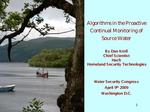Description
The objectives of this study are: to convey how a service laboratory is generating standard operating procedures for the US Environmental Protection Agency’s draft Method 1622: Cryptosporidium in Water by Filtration/IMS/FA, hereafter Method 1622; and, to assist purveyors, engineers, laboratories and regulators in identifying essential components of any method for successful protozoan detection. The laboratory has performed the Information Collection Rule Protozoan Detection Method (ICR Method) on hundreds of different water sources as well as performing work on validation of Method 1622. The ICR method is the most widely used method in the United States. Method 1622 is published as a draft method and numerous validation experiments continue to be performed to assess its accuracy and precision. Both methods have several components: sampling, particulate extraction, selective separation, staining, identification, and quality control. Also, recoveries of Cryptosporidium from DI, raw and finished water using ICR and 1622 methods were made. Oocysts were purified using discontinuous sucrose and cesium chloride centrifugation gradients. Giardia lamblia cysts were purified using a 1M sucrose gradient followed by a step gradient of Percoll(R) 1.05 and 1.09 specific gravity. Cysts were stored in an antibiotic solution composed of 500,000 units Penicillin, 500,000 ug Streptomycin, and 50 ug Gentomycin, and used within a month.
Product Details
- Published:
- 01/01/1998
- ISBN(s):
- 0898679796
- Number of Pages:
- 8
- File Size:
- 1 file
- Note:
- This product is unavailable in Ukraine, Russia, Belarus





